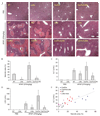Alterations in xenobiotic metabolism in the long-lived Little mice
- PMID: 17521389
- PMCID: PMC2859448
- DOI: 10.1111/j.1474-9726.2007.00300.x
Alterations in xenobiotic metabolism in the long-lived Little mice
Abstract
Our previous microarray expression analysis of the long-lived Little mice (Ghrhr(lit/lit)) showed a concerted up-regulation of xenobiotic detoxification genes. Here, we show that this up-regulation is associated with a potent increase in resistance against the adverse effects of a variety of xenobiotics, including the hepatotoxins acetaminophen and bromobenzene and the paralyzing agent zoxazolamine. The classic xenobiotic receptors Car (Constitutive Androstane Receptor) and Pxr (Pregnane X Receptor) are considered key regulators of xenobiotic metabolism. Using double and triple knockout/mutant mouse models we found, however, that Car and Pxr are not required for the up-regulation of xenobiotic genes in Little mice. Our results suggest instead that bile acids and the primary bile acid receptor Fxr (farnesoid X receptor) are likely mediators of the up-regulation of xenobiotic detoxification genes in Little mice. Bile acid levels are considerably elevated in the bile, serum, and liver of Little mice. We found that treatment of wild-type animals with cholic acid, one of the major bile acids elevated in Little mice, mimics in large part the up-regulation of xenobiotic detoxification genes observed in Little mice. Additionally, the loss of Fxr had a major effect on the expression of the xenobiotic detoxification genes up-regulated in Little mice. A large fraction of these genes lost or decreased their high expression levels in double mutant mice for Fxr and Ghrhr. The alterations in xenobiotic metabolism in Little mice constitute a form of increased stress resistance and may contribute to the extended longevity of these mice.
Figures






Comment in
-
Long-lived dwarf mice: are bile acids a longevity signal?Aging Cell. 2007 Aug;6(4):421-3. doi: 10.1111/j.1474-9726.2007.00309.x. Aging Cell. 2007. PMID: 17578511
References
-
- Alpini G, Glaser SS, Ueno Y, Rodgers R, Phinizy JL, Francis H, Baiocchi L, Holcomb LA, Caligiuri A, LeSage GD. Bile acid feeding induces cholangiocyte proliferation and secretion: evidence for bile acid-regulated ductal secretion. Gastroenterology. 1999;116:179–186. - PubMed
-
- Alvaro D, Gigliozzi A, Attili AF. Regulation and deregulation of cholangiocyte proliferation. J. Hepatol. 2000;33:333–340. - PubMed
-
- Amador-Noguez D, Yagi K, Venable S, Darlington G. Gene expression profile of long-lived Ames dwarf mice and Little mice. Aging Cell. 2004;3:423–441. - PubMed
-
- Ansher SS, Dolan P, Bueding E. Chemoprotective effects of two dithiolthiones and of butylhydroxyanisole against carbon tetrachloride and acetaminophen toxicity. Hepatology. 1983;3:932–935. - PubMed
-
- Arosio B, Gagliano N, Fusaro LM, Parmeggiani L, Tagliabue J, Galetti P, De Castri D, Moscheni C, Annoni G. Aloe-Emodin quinone pretreatment reduces acute liver injury induced by carbon tetrachloride. Pharmacol. Toxicol. 2000;87:229–233. - PubMed
Publication types
MeSH terms
Substances
Grants and funding
LinkOut - more resources
Full Text Sources
Medical
Molecular Biology Databases

